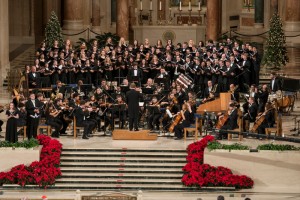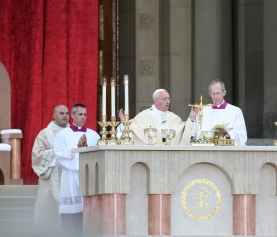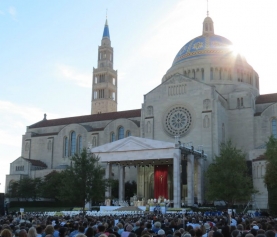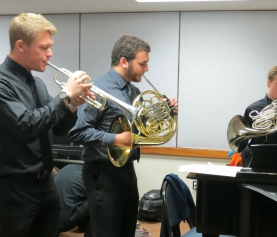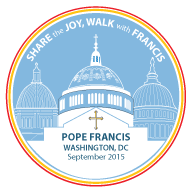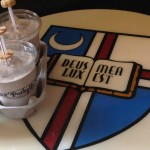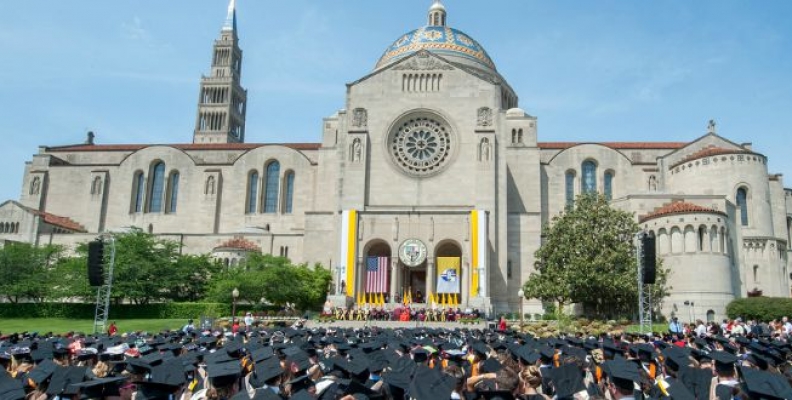
The Basilica and CUA: A Seamless Relationship
When thousands of worshippers gather on the 3.6-acre mall of The Catholic University of America on Sept. 23, they will witness the first public Mass celebrated by Pope Francis in the United States. As they watch the Holy Father on the East Portico of the Basilica of the National Shrine of the Immaculate Conception, they will be treated to a beautiful backdrop.
Towering behind the outdoor papal altar that was specially designed by CUA architecture and planning students will be the largest Catholic Church in North America and one of the 10 largest churches in the world. The cross atop the Great Dome of the Basilica will rise 237 feet above the pontiff. The dome, made of blue and yellow polychrome tiles and 108-feet in diameter, will provide a beautiful background image for attendees’ photos, as well as their memories.
When Pope Francis looks out at the congregation he will have an impressive view of his own — the landscape and architecture of the largest and greenest college campus in Washington, D.C. Framing the Mall, he will see some of the University’s most historic, grand buildings such as the Collegiate, Gothic-style Father O’Connell Hall (built in 1914) and Gibbons Hall (built in 1911) and the Romanesque-style McMahon Hall (built in 1892).
To anyone witnessing this historic moment there will be no divide between the University and the Basilica. The historic outdoor papal Mass will take place in one spectacular location.
The Basilica, once part of the University, is now a separate entity. But the two Catholic institutions share a close and seamless relationship. “The Basilica of the National Shrine of the Immaculate Conception is integral to our University community,” says President John Garvey.
“It not only adds to the beauty of our campus, but to our faith life as well. From regular Sunday worship in the lower Crypt Church to our University-wide Mass of the Holy Spirit in the Great Upper Church that marks the beginning of our academic year to our annual Commencement ceremonies, the Basilica is the setting for many of the University’s most important moments,” says Garvey.
With support from Pope Pius X in 1913, Bishop Thomas J. Shahan, the fourth rector of Catholic University, launched a fundraising campaign that culminated in the laying of the cornerstone of a church dedicated to the Blessed Virgin Mary on Sept. 23, 1920. The first Mass was held in the national shrine on Easter Sunday 1924. The Crypt Church was completed in 1926. The Great Depression and World War II put construction of the Great Upper Church superstructure on hold. The national shrine incorporated separately from the University in 1948. Construction resumed in 1954 and was completed in 1959.
“Since the inception of the Shrine, the University and the National Shrine have been intimately involved, especially regarding the spiritual life of the University,” says Monsignor Walter R. Rossi, Basilica rector. “To this day we continue to collaborate with annual events such as the Christmas Concert for Charity, student convocations, the Mass of the Holy Spirit, and Commencement exercises. Working together now in preparation for the visit of Pope Francis seems like a natural extension of our many joint events which are always a positive, effortless experience thanks to the wonderful cooperation of President Garvey, Frank Persico [vice president for University relations and chief of staff], and the entire President’s office.”
“It would be hard to imagine the University without the Basilica,” adds Garvey. “We are fortunate to share such a strong relationship with ‘America’s Catholic Church’ and its staff.”
As the University and the Basilica of the National Shrine of the Immaculate Conception prepare to host Pope Francis during his historic visit to the United States, members of the University community share what the Basilica means to them.
Leo Nestor
Justine Bayard Ward Professor, director of the Institute of Sacred Music at CUA
Conductor for CUA Chamber Choir and Symphony Orchestra at Papal Mass
Benjamin T. Rome School of Music
When in 1913 the Board of Trustees of The Catholic University of America donated land at the southwest corner of campus for the construction of a national shrine to honor Mary under the title of the Immaculate Conception, who would have imagined that Bishop Shahan’s vision of a “monument of love and gratitude, a great hymn in stone” would keep that corner parcel of land and its eventual basilica so close to the CUA community?
Far greater than merely a beautiful place for our occasional concerts and convocations, it has from its inception been our spiritual oasis. There the University celebrates major liturgies in the Great Upper Church at which our chancellor Donald Cardinal Wuerl often presides. There students, faculty, and staff attend daily and Sunday Masses, regularly availing themselves of the Sacrament of Reconciliation in the Crypt Church, the very heart of the Basilica.
In this holy subterranean church evocative of the catacombs, the University community celebrates Eucharist each Sunday of the academic year at 4 p.m. While the Crypt Church with its noble acoustic and tracker organ provide an intimate space for music making, the expanse of the Great Upper Church has become the locus for our annual Christmas Concert for Charity in tandem with the Basilica musicians, which in December celebrates its 26th year.
On the East Portico of the Basilica on Sept. 23, Pope Francis will celebrate the Mass of canonization of Fray Junípero Serra, apostle of California, at which the CUA Chamber Choir and Symphony Orchestra will join with many other musicians from throughout the Archdiocese of Washington. Though it is not a parish and is shared with all who come to pray, worship, and confess there, the Basilica is and has always been integral to the spiritual and liturgical life of the University.
Victor David, B.A. 2014
Altar server
I feel that being at the Basilica, both as a student and now as an alumnus of CUA, represents several things. It represented the beginning of my time at CUA when I attended the Mass during Orientation. Then it represented an end as I received my diploma on the east steps during Commencement. And because of my sustained involvement with the Basilica, it represents a continued relationship with both CUA and my faith life. In all these things, the Basilica has been a home, both spiritually and physically — I can’t help but feel at peace whenever I am there.
Serving at a Mass in the Basilica still fills me with great emotion even after having done so for almost five years. Being near the altar, looking out at the congregation, and reflecting on all the beautiful sacred art have truly helped me grow in my faith journey. For me, there is no greater honor as a young layman than to assist the priest in his role to bring Christ to others in the Eucharist. Though sometimes it can be a bit hectic when serving or as a master of ceremonies (the head server) at any given Mass, I can always find solace in the fact that what I am doing is helping others on their journey of faith. And to do that in a place as magnificent as the Basilica, I can’t help but count it as one of the great blessings in my life.
Ajani Gibson, B.A. 2015
Assistant to the Basilica’s director of liturgy
I am responsible for coordinating all the priests who say Mass and hear confessions at the Basilica. I also coordinate the 300 liturgical volunteers who assist at the various Masses at the Basilica throughout the year. During my undergrad years, I was one of the regular masters of ceremonies for the Basilica.
It is a special place. The unique nature of the Basilica is not limited to its size or grandeur; rather, it is found in how the Basilica becomes a home to thousands of pilgrims and many CUA students. You are able to find yourself reflected in the many chapels. For example, my favorite chapel is the Mary, Mother of Africa, Chapel. In it is this beautifully carved mahogany crucifix, which is similar to a crucifix in my home parish in New Orleans. For someone coming from so far and being able to have something I could connect with from home makes the Basilica a safe haven. I think by having it adjacent to campus, we, as a university, are constantly reminded of our responsibility as The Catholic University of America to set the standard for Catholic life for young adults and our responsibility to share the Catholic faith with our country.
Rev. Justin Ross, O.F.M. Conv.
Associate chaplain for liturgy and worship
CUA Office of Campus Ministry
This time of year, you will see students posting photos of themselves, standing in front of the Basilica, to Instagram. Their message is “I’m back home!” For so many students, the Basilica is part of their home and their community at CUA.
And that is perhaps most apparent in their dedication to the 4 p.m. Sunday Mass held during the school year. It is one of three student Masses held each Sunday; the other two are held in campus chapels, one in the morning and one in the evening. They each have a different feel to them. The Crypt Church Mass has a feeling of grandiosity because of the space and the sacred music, yet it’s intimate. The students are readers, servers, Eucharistic ministers, liturgical ministers, choir members, and organ players. It is their Mass, and they are ever appreciative that they have this beautiful sacred space in which to worship.
If you look at the origins of the Basilica, it was conceived as a chapel for Catholic University, which in its early days had already outgrown its small and only chapel in Caldwell Hall. And even though the Basilica has grown into the national church of the Catholic Church in America, it remains a place of worship and spirituality for our students. Our relationship with the Basilica remains strong and it is because of the generosity of its leaders that students can continue to call it part of their campus home.

